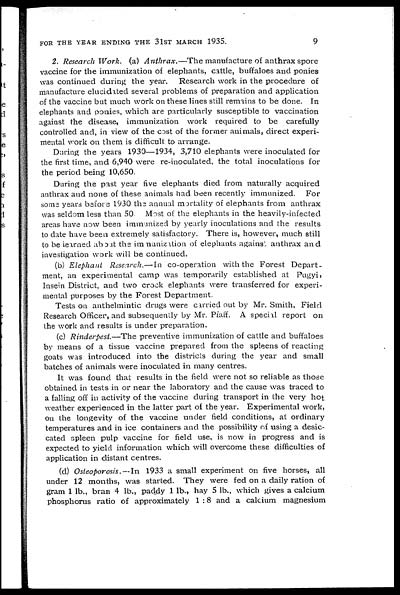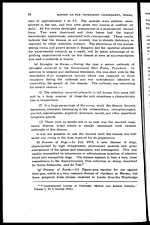Medicine - Veterinary > Civil Veterinary Departments > 1910-1941 - Annual report on the Civil Veterinary Department, Burma (including the Insein Veterinary School) > 1932-1941 > 1935
(183) Page 9
Download files
Individual page:
Thumbnail gallery: Grid view | List view

FOR THE YEAR ENDING THE 31ST MARCH 1935. 9
2. Research Work. (a) Anthrax.—The manufacture of anthrax spore
vaccine for the immunization of elephants, cattle, buffaloes and ponies
was continued during the year. Research work in the procedure of
manufacture elucidated several problems of preparation and application
of the vaccine but much work on these lines still remains to be done. In
elephants and ponies, which are particularly susceptible to vaccination
against the disease, immunization work required to be carefully
controlled and, in view of the cost of the former animals, direct experi-
mental work on them is difficult to arrange.
During the years 1930—1934, 3,710 elephants were inoculated for
the first time, and 6,940 were re-inoculated, the total inoculations for
the period being 10,650.
During the past year five elephants died from naturally acquired
anthrax and none of these animals had been recently immunized. For
some years before 1930 the annual mortality of elephants from anthrax
was seldom less than 50. Most of the elephants in the heavily-infected
areas have now been immunized by yearly inoculations and the results
to date have been extremely satisfactory. There is, however, much still
to be learned about the immunization of elephants against anthrax and
investigation work will be continued.
(b) Elephant Research.— In co-operation with the Forest Depart-
ment, an experimental camp was temporarily established at Pugyi,
Insein District, and two crock elephants were transferred for experi-
mental purposes by the Forest Department.
Tests on anthelmintic drugs were carried out by Mr. Smith, Field
Research Officer, and subsequently by Mr. Ptaff. A special report on
the work and results is under preparation.
(c) Rinderpest.—The preventive immunization of cattle and buffaloes
by means of a tissue vaccine prepared from the spleens of reacting
goats was introduced into the districts during the year and small
batches of animals were inoculated in many centres.
It was found that results in the field were not so reliable as those
obtained in tests in or near the laboratory and the cause was traced to
a falling off in activity of the vaccine during transport in the very hot
weather experienced in the latter part of the year. Experimental work,
on the longevity of the vaccine under field conditions, at ordinary
temperatures and in ice containers and the possibility of using a desic-
cated spleen pulp vaccine for field use, is now in progress and is
expected to yield information which will overcome these difficulties of
application in distant centres.
(d) Osteoporosis.—In 1933 a small experiment on five horses, all
under 12 months, was started. They were fed on a daily ration of
gram 1 lb., bran 4 lb., paddy 1 lb., hay 5 lb., which gives a calcium
phosphorus ratio of approximately 1 : 8 and a calcium magnesium
Set display mode to: Large image | Zoom image | Transcription
Images and transcriptions on this page, including medium image downloads, may be used under the Creative Commons Attribution 4.0 International Licence unless otherwise stated. ![]()
| Permanent URL | https://digital.nls.uk/75802954 |
|---|




